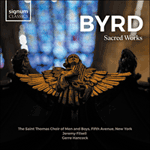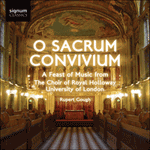The Feast of Corpus Christi commemorates the institution and gift of the Holy Eucharist, traditionally celebrated in the Western Church on the Thursday after Trinity Sunday. (In the early church this commemoration was held on its natural day in the Christian calendar, Maundy Thursday, on which the Eucharist was instituted at the Last Supper; however, in reserving this day as part of the Passion ceremonies, a new feast day was recognized in 1264 and set on the first free Thursday after Eastertide.) The texts reflect a sacrificial tone as befits the Corpus Christi celebrations, embodying the imagery of the ingestion of blood and body. As the medieval symbol of the Body of Christ illustrates, the mother Pelican’s beak penetrates her own breast, giving life-blood to benefit the hunger of her young. Ironically, Byrd chose the bright and cheerful mixolydian mode for his setting. The Introit
Cibavit eos is delightfully radiant, and celebrates the biblical miracle of wheat and honey from the rock. Here the antiphon is followed by a Psalm verse (80:1) for reduced voices, and an energetic and semi-homophonic setting of the doxology (‘Gloria Patri’) with a deliberate break before the ‘Sicut erat’, quite typical in Byrd’s Introit settings. As the liturgy would dictate, the antiphon is repeated at the end of the work (although this is not directed in the printed sources).
from notes by David Skinner © 1996
La célébration du Corpus Christi commémore l’institution et le don de la Sainte Eucharistie, traditionnellement célébrée par l’Eglise latine le jeudi après la fête de la Trinité (l’église primitive se livrait à cette commémoration en son jour naturel du calendrier chrétien, soit le jeudi saint, qui correspond au jour de l’institution de l’Eucharistie pendant la Cène; néanmoins, en faisant figurer cette journée dans le cadre des cérémonies de la Passion de Jésus-Christ, un nouveau jour de célébration était adopté en 1264, qui tombait le premier jeudi après la saison de Pâques). Les textes reflètent le ton sacrificiel qui convient aux célébrations du Corpus Christi et sont empreints d’un symbolisme qui évoque l’ingestion du corps et du sang. Comme l’illustre le symbole médiéval du Corps du Christ, le bec du pélican pénètre en sa poitrine pour faire jaillir le sang qui nourrira sa progéniture. Ironiquement, Byrd opta pour la légèreté, la gaieté du mode mixolydien dans la composition de sa mise en musique. L’Introït
Cibavit eos, rayonnant d’une joie délicieuse, célèbre le miracle biblique du blé et du miel jaillissant du rocher. À cet endroit, l’antienne est suivie des versets d’un psaume (80:1) pour voix réduites et d’une mise en musique pleine d’énergie et semi-homophone de la doxologie («Gloria Patri»), marquant une pause volontaire avant le «Sicut erat», une technique somme toute assez typique des mises en musique d’Introïts composées par Byrd. Liturgie oblige, l’antienne est répétée à la fin de l’œuvre (bien qu’aucune indication ne le suggère dans les sources imprimées).
extrait des notes rédigées par David Skinner © 1996
Français: Alexandre Blanchard
Das Fest zum Fronleichnam gedenkt der Institution und der Gabe des heiligen Abendmahls, das in westlichen Kirchen traditionell am Donnerstag nach Trinitatis gefeiert wird. (In der frühen Kirche wurde dieses Gedenken dem Kirchenkalender zufolge an seinem ursprünglichen Tag abgehalten, am Gründonnerstag, an dem der Abendmahlsgottesdienst das letzte Abendmahl einleitete. Da dieser Tag einem Teil der Passionsfeierlichkeiten vorbehalten wurde, konnte 1264 der erste freie Donnerstag nach Ostern als ein neuer Feiertag anerkannt werden.) Der Messetext gibt auf gebührende Art und Weise den Opferton des Fronleichnam wider und verkörpert das Bild des Aufnehmens von Blut und Leib. Wie im mittelalterlichen Symbol des Körpers Jesu dargestellt, durchdringt der Schnabel des Pelikanweibchens seine eigene Brust und gibt lebenspendendes Blut, um den Hunger seiner Jungen zu stillen. Byrd jedoch wählte für seine Vertonung recht ironisch die helle und fröhliche mixolydische Tonart. Der Introitus
Cibavit eos ist wunderbar strahlend und preist das biblische Wunder von Weizen und Honig. Hier folgt nach der Antiphon ein Psalm (80:1) für verringerte Stimmen und eine dynamische, semi-homophone Vertonung der Lobpreisung („Gloria Patri“) mit einer entschlossenen Pause vor dem „Sicut erat“, die für die Introitus-Vertonungen von Byrd recht bezeichnend ist. Nach Vorgabe der Liturgie wird die Antiphon am Ende des Werkes wiederholt (obwohl dieses in den schriftlichen Quellen nicht angegeben wird).
aus dem Begleittext von David Skinner © 1996
Deutsch: Ute Mansfeldt


 Byrd: Sacred Works
Byrd: Sacred Works O sacrum convivium
O sacrum convivium
